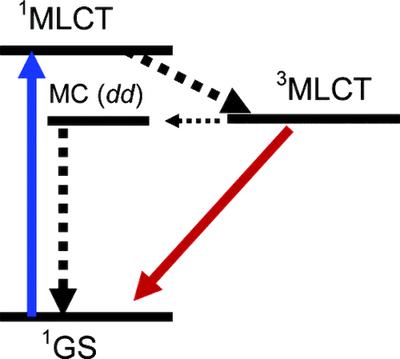Thinking more about my earlier post,
Key questions about organometallic materials for LEDs, I realised there is a subtlety that is sometimes overlooked when interpreting experimental data on these materials. The radiative and non-radiative decay rates of the emitting state are never directly measured. Rather, one
actually measures the total lifetime tau (or decay rate) of the emitting state and the PLQY (PhotoLuminescence Quantum Yield). This is the ratio of the number of emitted photons to the number of absorbed photons (see the blue and red arrows below).

One then uses the following two equations to deduce the radiative and non-radiative decay rates.


For just one of many examples, of how this is done, see this
paper, by Lawrence Lo and collaborators.
However, this analysis
assumes that one hundred per cent of the 1MCLT state decays to the 3MLCT state. i.e., that there is NO significant non-radiative decay of this state via other channels (e.g., the MC state shown above).
 One then uses the following two equations to deduce the radiative and non-radiative decay rates.
One then uses the following two equations to deduce the radiative and non-radiative decay rates. One then uses the following two equations to deduce the radiative and non-radiative decay rates.
One then uses the following two equations to deduce the radiative and non-radiative decay rates.
I guess the correct interpretation of the calculated rates would be something like:
ReplyDeletek_R is 1MLCT -> 3MLCT -> 1GS (radiative)
k_NR is 1MLCT -> 3MLCT -> MC -> 1GS (nonradiative)
+ 1MLCT -> 1GS (nonradiative)
+ 1MLCT -> MC -> 1GS (nonradiative)
+ every other non-radiative path.
To what extent does this difference in k_NR matter in terms of the conclusions drawn thus far? Have people looked at non-radiative pathways in enough detail?